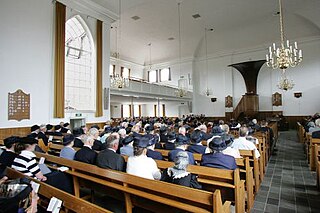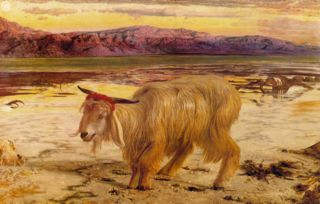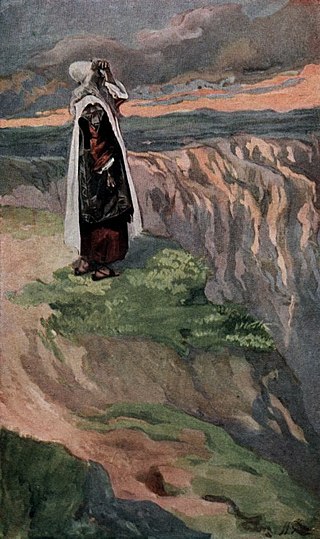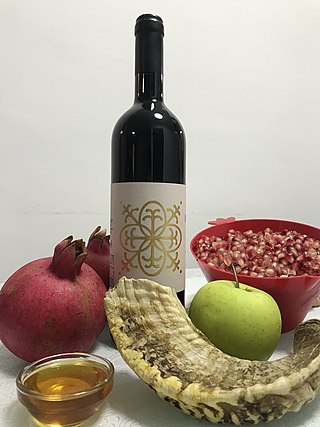Related Research Articles

Jewish holidays, also known as Jewish festivals or Yamim Tovim, are holidays observed by Jews throughout the Hebrew calendar. They include religious, cultural and national elements, derived from three sources: mitzvot, rabbinic mandates, the history of Judaism, and the State of Israel.

Passover, also called Pesach, is a major Jewish holiday, one of the three pilgrimage festivals, that celebrates the Biblical story of the Israelites' escape from slavery in Egypt. The Passover ritual is thought by modern scholars to have its origins in an apotropaic rite, unrelated to the Exodus, to ensure the protection of a family home.

Sabbath in Christianity is the inclusion of a Sabbath day in Christianity, a day set aside for rest and worship, a mandatory practice described in the Ten Commandments in line with God's blessing of the seventh day (Saturday) making it holy, "because on it God rested from all his work that he had done in creation". The practice was associated with the assembly of the people to worship in synagogues on the day known as Shabbat.

Shabbat or the Sabbath, also called Shabbos by Ashkenazim, is Judaism's day of rest on the seventh day of the week—i.e., Saturday. On this day, religious Jews remember the biblical stories describing the creation of the heaven and earth in six days and the redemption from slavery and the Exodus from Egypt, and look forward to a future Messianic Age. Since the Jewish religious calendar counts days from sunset to sunset, Shabbat begins in the evening of what on the civil calendar is Friday.
Christian observance of Passover is found among Assemblies of Yahweh, Messianic Jews, and some congregations of the Church of God. It is often linked to the Christian holiday and festival of Easter. Often, only an abbreviated seder is celebrated to explain the meaning in a time-limited ceremony. The redemption from the bondage of sin through the sacrifice of Christ is celebrated, a parallel of the Jewish Passover's celebration of redemption from bondage in the land of Egypt.
Chol HaMoed, a Hebrew phrase meaning "mundane of the festival", refers to the intermediate days of Passover and Sukkot. As the name implies, these days mix features of chol (mundane) and moed (festival).

Acharei Mot is the 29th weekly Torah portion in the annual Jewish cycle of Torah reading. It is the sixth weekly portion in the Book of Leviticus, containing Leviticus 16:1–18:30. It is named after the fifth and sixth Hebrew words of the parashah, its first distinctive words.

Emor is the 31st weekly Torah portion in the annual Jewish cycle of Torah reading and the eighth in the Book of Leviticus. The parashah describes purity rules for priests, recounts the holy days, describes the preparations for the lights and bread in the sanctuary, and tells the story of a blasphemer and his punishment. The parashah constitutes Leviticus 21:1–24:23. It has the most verses of any of the weekly Torah portions in the Book of Leviticus, and is made up of 6,106 Hebrew letters, 1,614 Hebrew words, 124 verses and 215 lines in a Torah Scroll.

The Hebrew Roots Movement (HRM) is a syncretic religious movement that advocates adherence to the Torah and believe that Jesus, whom they often refer to by the Hebrew name Yeshua, is the Messiah. The movement emphasizes and promotes the belief that the Law of Moses was not abolished by Jesus and is, therefore, still in effect for his followers. Because HRM believes the Mosaic law is still active, it advocates the keeping of the seventh-day Sabbath; biblical feasts; laws of Kashrut; and circumcision. Some HRM followers also choose to wear tzitzit and other Jewish religious items. However, HRM followers do not generally follow Judaism or embrace the Talmud. Unlike other Christians, most HRM followers reject the traditional holidays of Christmas and Easter, insisting that they are pagan traditions.

Pinechas, Pinchas, Pinhas, or Pin'has is the 41st weekly Torah portion in the annual Jewish cycle of Torah reading and the eighth in the Book of Numbers. It tells of Phinehas's killing of a couple, ending a plague, and of the daughters of Zelophehad's successful plea for land rights. It constitutes Numbers 25:10–30:1. The parashah is made up of 7,853 Hebrew letters, 1,887 Hebrew words, 168 verses, and 280 lines in a Torah scroll.
Special Shabbatot are Jewish Shabbat days on which special events are commemorated. Variations in the liturgy and special customs differentiate them from the other Shabbats and each one is referred to by a special name. Many communities also add piyyutim on many of these special Shabbatot. Two such Shabbats, Shabbat Mevarchim—the Shabbat preceding a new Hebrew month—and Shabbat Rosh Chodesh can occur on several occasions throughout the year. The other special Shabbats occur on specific sabbaths before or coinciding with certain Jewish holidays during the year according to a fixed pattern.

In Abrahamic religions, the Sabbath or Shabbat is a day set aside for rest and worship. According to the Book of Exodus, the Sabbath is a day of rest on the seventh day, commanded by God to be kept as a holy day of rest, as God rested from creation. The practice of observing the Sabbath (Shabbat) originates in the biblical commandment "Remember the sabbath day, to keep it holy".

The Sabbath is a weekly day of rest or time of worship given in the Bible as the seventh day. It is observed differently in Judaism and Christianity and informs a similar occasion in several other faiths. Observation and remembrance of Sabbath is one of the Ten Commandments considered to be the fourth in Judaism, Eastern Orthodoxy, and most Protestant traditions, and the third in Roman Catholic and Lutheran traditions.
The modern Hebrew calendar has been designed to ensure that certain holy days and festivals do not fall on certain days of the week. As a result, there are only four possible patterns of days on which festivals can fall.

Rosh HaShanah is the New Year in Judaism. The biblical name for this holiday is Yom Teruah. It is the first of the High Holy Days, as specified by Leviticus 23:23–25, that occur in the late summer/early autumn of the Northern Hemisphere. Rosh Hashanah begins ten days of penitence culminating in Yom Kippur, as well as beginning the cycle of autumnal religious festivals running through Sukkot which end on Shemini Atzeret in Israel and Simchat Torah everywhere else.

"Remember the Sabbath day, to keep it holy" is one of the Ten Commandments found in the Torah.

Some Christian groups incorporate Jewish holidays into their religious practice, typically altering and reinterpreting their observation to suit a supersessionist theology.
Christian observances of Yom Kippur occur when a Christian-style Day of Atonement models itself on the Jewish holiday of Yom Kippur.
Haymanot is the branch of Judaism which is practiced by the Beta Israel, also known as Ethiopian Jews.

Ezekiel 45 is the forty-fifth chapter of the Book of Ezekiel in the Hebrew Bible or the Old Testament of the Christian Bible. This book contains the prophecies attributed to the prophet/priest Ezekiel, and is one of the Books of the Prophets. The final section of Ezekiel, chapters 40-48, give the ideal picture of a new temple. The Jerusalem Bible refers to this section as "the Torah of Ezekiel". In particular, chapters 44–46 record various laws governing the rites and personnel of the sanctuary, as a supplement to Ezekiel's vision.
References
- ↑ "After the Crucifixion: The Three Days and the Three Nights". Theological FAQs. Blue Letter Bible.
- ↑ Parsons, John J. "Reshit Katzir: Messiah as the Beginning of the Harvest". Hebrew for Christians.
- ↑ "FAQ: Is a 'high day' a weekly Sabbath?". Sabbath.org. Church of the Great God.
- ↑ Chumney, Eddie. "The Festival of Unleavened Bread (Hag HaMatzah)". The Seven Festivals of the Messiah. Feasts of the Lord.
- ↑ Seventh-day Adventists Believe... Review & Herald Publishing Assn. 1988.